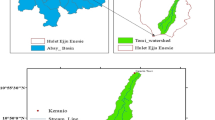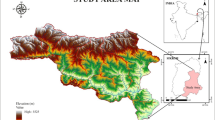Abstract
Gully erosion is one of the exogenetic processes which changes the curvature of the earth. The rate of gully erosion is high in the arid and semi-arid regions experiencing less amount of vegetation cover. Adana Province being one of the major provinces in the Mediterranean Sea Region due to the presence of fertile lands, agricultural activities, and densely populated areas. This research produces gully erosion susceptibility surfaces over the Çukurova Plain in the Adana sub-region of Turkey. To estimate gully erosion susceptibility, various inputs such as land use map, lithology map slope map, and aspect map were used as gully erosion prediction factors. A classified 30-m spatial resolution Landsat satellite imagery and digital elevation models were used as the ancillary data inputs to provide the best results. The objective of this study is to find out the areas affected by gully erosion in the Adana Province of Turkey. For the purpose of analysis, multi-criteria decision analysis techniques have been applied. The vegetation of this proposed area is sparse which leads to the rapid erosion of soil and also most of the areas are associated with the badlands and gullies which are associated with steep slopes. This study reveals that the impact of gully erosion is high on the northern and north western sides of the provinces where the density of the drainage network is high. Those non-perennial small rivers create many small badlands in this area which leads to loss of fertile soil. This research is very helpful to take various planning strategies for the physical and social development of the study area where agricultural activities are dominant. The maps which are produced in this study will be helpful for the planners, decision makers to develop future planning strategies for the sustainable growth and development of this area. Therefore, the used methodology can be used to generate gully erosion susceptibility surfaces in other areas of the Mediterranean region of Turkey that have similar geographical conditions.













Similar content being viewed by others
References
Anabalagan R (1992) Landslide hazard evaluation and zonation mapping in mountainous terrain. Eng Geol 32:269–277
Arabameri A, Pradhan B, Lombardo L (2019) Comparative assessment using boosted regression trees, binary logistic regression, frequency ratio and numerical risk factor for gully erosion susceptibility modelling. CATENA 183:104223
Begueíra S (2006) Identifying erosion areas at basin scale using remote sensing data and GIS, a case study in a geologically complex mountain basin in the Spanish Pyrenees. Int J Remote Sens 27:4585–4598
Carrara A, Cardinali M, Detti R, Guzzetti F, Pasqui V, Reichenbach P (1991) GIS techniques and statistical models in evaluating landslide hazard. Earth Surf Proc Landf 16:427–445
Casali J, Gimenez R, Bennett S (2009) Gully erosion processes: monitoring and modelling’. Earth Surf Proc Landf 34:1839–1840
Cevik E, Topal T (2003) GIS-based landslide susceptibility mapping for a problematic segment of the natural gas pipeline, Hendek (Turkey). Environ Geol 44:949–962
Daba W, Rieger P (2003) Strauss assessment of gully erosion in eastern Ethiopia using photogrammetric techniques. CATENA 50(2–4):273–291
Dai FC, Lee CF, Li J, Xu ZW (2001) Assessment of landslide susceptibility on the natural terrain of Lanta Island, Hong Kong. Environ Geol 40:381–391
De Vente J, Poesen J, Verstraeten G (2005) The application of semi-quantitative methods and reservoir sedimentation rates for the prediction of basin sediment yield in Spain. J Hydrol 305(1–4):63–86
denBiggelaar C, Lal R, Wiebe K, Breneman V (2004) The global impact of soil erosion on productivity I: absolute and relative erosion-induced yield losses. Adv Agron 81:1–48
Dramis F, Gentili B (1977) Contributoallo studio delleacclivita` deiverstiell’Appennino Umbro. Marchigiano Stud Geol Camerti 3:153–164
EEA (2005) The European environment, state and outlook 2005. European Environmental Agency, Copenhagen
García Ruiz JM (2010) The effects of land use on soil erosion in Spain: a review. CATENA 81(1):1–11. https://doi.org/10.1016/j.catena.2010.01.001
GhorbaniNejad S, Falah F, Daneshfar M, Haghizadeh A, Rahmati O (2017) Delineation of groundwater potential zones using remote sensing and GIS-based data-driven models. Geocarto Int 32(2):167–187
Golestani G, Issazadeh L, Serajamani R (2014) Lithology effects on gully erosion in Ghoori chay watershed using RS and GIS. Int J Biosci 4(2):71–76
Grimm M, Jones J, Montanarella L (2001) Soil erosionrisk in Europe [online]. European Communities Report EUR19939 EN (Revised in 2002). http://www.env-edu.gr/Documents/Soil%20Erosion%20Risk%20in%20Europe.pdf. Accessed 24 Jan 2012
Gutiérrez ÁG, Schnabel S, Contador FL (2009) Gully erosion, land use and topographical thresholds during the last 60 years in a small rangeland catchment in SW Spain. Land Degrad Dev 20(5):535–550
Guzzetti F, Carrara A, Cardinali M, Reichenbach P (1999) Landslide hazard evaluation: a review of current techniques and their application in a multi-scale study, Central Italy. Geomorphology 31:181–216
Imwangana FM, Dewitte O, Ntombi M, Moeyersons J (2014) Topographic and road control of mega-gullies in Kinshasa (DR Congo). Geomorphology 217:131–139
Jaafari A, Najafi A, Pourghasemi HR, Rezaeian J, Sattarian A (2014) GIS-based frequency ratio and index of entropy models for landslide susceptibility assessment in the Caspian forest, northern Iran. Int J Environ Sci Technol 11(4):909–926
Kariminejad N, Hosseinalizadeh M, Pourghasemi H R, MajidOwnegh M, Rossi M (2020) Factors affecting gully-head activity in a hilly area under a semiarid climate in Iran. In: Shit PK, Pourghasemi HR, Bhunia GS (eds) Advances in science, technology and ınnovation, ınterdisciplinary series for sustainable development gully erosion studies from India and surrounding regions, pp 369–380
Khawlie M, Awad M, Shaban A, BouKheir R, Abdallah C (2002) Remote sensing for environmental protection of the eastern Mediterranean rugged mountainous areas, Lebanon. ISPRS J Photogramm Remote Sens 57:13–23
Kirkby MJ, Bracken LJ (2009) Gully processes and gully dynamics. Earth Surf Process Landf J Br Geomorphol Res Group 34(14):1841–1851
Kropacek C, Schillaci R, Salvini MM (2016) Assessment of gully erosion in the Upper Awash, Central Ethiopian highlands based on a comparison of archived aerial photographs and very high resolution satellite images Geogr. Fis Din Quaternaria 39(2):161–170
Maharaj R (1993) Landslide processes and landslide susceptibility analysis from an upland watershed: a case study from St Andrew, Jamaica, West Indies. Eng Geol 34:53–79
Martin YE, Franklin SE (2005) Classification of soil- and bedrock-dominated landslides in British Columbia using segmentation of satellite imagery and DEM data. Int J Remote Sens 26:1505–1509
Nagarajan R, Roy A, Vinod Kumar R, Mukherjee A, Khire MV (2000) Landslide hazard susceptibility mapping based on terrain and climatic factors for tropical monsoon regions. Bull Eng Geol Environ 58:275–287
Nampak H, Pradhan B, Mojaddadi Rizeei H, Park HJ (2018) Assessment of land cover and land use change impact on soil loss in a tropical catchment by using multitemporal SPOT-5 satellite images and Revised Universal Soil Loss Equation model. Land Degrad Dev 29(10):3440–3455
Oostwoud Wijdenes D (2000) Spatial distribution of gully head activity and sediment supply along an ephemeral channel in a Mediterranean environment. CATENA 39:147–167
Poesen J (2002) Gully erosion in dryland environments. In: Bull LJ, Kirkby MJ (eds) Drylandrivers: hydrology and geomorphology of semi-arid channels. Wiley, Chichester, pp 229–260
Poesen J (2011) Challenges in gully erosion research. Landf Anal 17:5–9
Poesen J, Vandaele K, Van Wesemael B (1996) Contribution of gully erosion to sediment production in cultivated lands and rangelands. In: Walling DE, Webb BW (eds) Erosion and sediment yield: global and regional perspectives, vol 236. IAHS Press, IAHS Publ., Wallingford, pp 251–266
Poesen J, Nachtergaele J, Verstraeten G, Valentin C (2003) Gully erosion and environmental change: importance and research needs. CATENA 50:91–133
Pulice I, Scarciglia F, Leonardi L, Robustelli G, Conforti M, Cuscino M, Lupiano V, Critelli S (2009) Studio multidisciplinare di forme e processidenudazionalinell’area di Vrica (Calabria orientale). Bollet Tino della Societa Geografica Italiana 87(I–II):399–414
Rahmati O, Samani AN, Mahdavi M, Pourghasemi HR, Zeinivand H (2015) Groundwater potential mapping at Kurdistan region of Iran using analytic hierarchy process and GIS. Arab J Geosci 8(9):7059–7071
Rizeei HM, Saharkhiz MA, Pradhan B, Ahmad N (2016) Soil erosion prediction based on land cover dynamics at the Semenyih watershed in Malaysia using LTM and USLE models. Geocarto Int 31(10):1158–1177
Servenay A, Prat C (2003) Erosion extension of indurated volcanic soils of Mexico by aerial photographs and remote sensing analysis. Geoderma 117:367–375
Torri D, Borselli L, Gariano SL, Greco R, Iaquinta P, Iovine G, Terranova OG (2012) Identifying gullies in the Mediterranean environment by coupling a complex threshold model and a GIS. RENDICONTI Online della Società Geologica Italiana 89(PART 1):441–443
Türkiye Meteoroloji Genel Müdürlüğü (Turkish Meteorological Service) https://www.mgm.gov.tr/eng/forecast-cities.aspx
UNEP (1997) United Nations Environment Programme
Valentin C, Poesen J, Li Y (2005) Gully erosion, impacts, factors and control. CATENA 63:132–153
Xia D, Deng Y, Wang S, Ding S, Cai C (2015) Fractal features of soil particle-size distribution of different weathering profiles of the collapsing gullies in the hilly granitic region, south China. Nat Hazards 79(1):455–478
Yang X, Ding Z, Fan X, Zhou Z, Ma N (2007) Processes and mechanisms of desertification in northern China during the last 30 years, with a special reference to the Hunshandake Sandy Land, eastern Inner Mongolia. CATENA 71:2–12
Zakerinejad R, Maerker M (2015) An integrated assessment of soil erosion dynamics with special emphasis on gully erosion in the Mazayjan basin, southwestern Iran. Nat Hazards 79(1):25–50
Funding
No.
Author information
Authors and Affiliations
Corresponding author
Ethics declarations
Conflict of Interest
No conflict of interest exists.
Ethical Approval
Yes.
Rights and permissions
About this article
Cite this article
Majumdar, S., Kose, M. & Chatterjee, U. Gully Erosion Mapping by Multi-criteria Decision Analysis Techniques and Geoinformatics in Adana Province, Turkey. Earth Syst Environ 6, 759–770 (2022). https://doi.org/10.1007/s41748-020-00198-y
Received:
Accepted:
Published:
Issue Date:
DOI: https://doi.org/10.1007/s41748-020-00198-y




